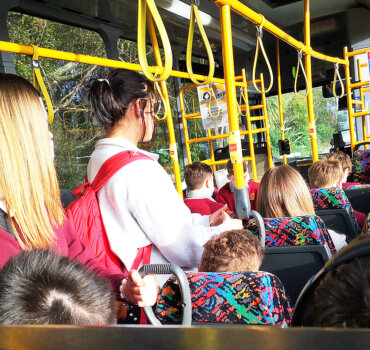
On the bus: There was standing room only on some peak time buses from Cambridge last week. Photo: Mary Anne Gill

On the bus: There was standing room only on some peak time buses from Cambridge last week. Photo: Mary Anne Gill
Twenty minutes can be shaved off the usual one-hour peak time bus commuting journey between Cambridge and Hamilton under radical plans unveiled last week.
Dedicated bus lanes, fewer stops, route changes, hourly services starting and finishing earlier and later in the day, better passenger waiting facilities and cutting through bureaucratic red tape were among recommendations adopted by the Waikato Regional Connections committee.
The changes will make bus travel to and from Cambridge more attractive, say the authors of a report to the committee, and come as last month there was a 103 per cent increase in passengers over August 2021. And at 7313 people for the month, the numbers are the highest since the prepay Bee Card was introduced two years ago.

Velodrome stop: A report recommends more refurbished bus stops like the one at the Velodrome. Photo: Mary Anne Gill
The more immediate solutions include the possible introduction of a bus/high occupancy vehicle lane between the Expressway southern interchange at Tamahere through to the SH26 roundabout in Hillcrest, a shortening of the route through Leamington and fewer stops in Cambridge and Hamilton.
The Cambridge to Hamilton Public Transport Corridor Study Report was prepared for the regional council’s Regional Connections committee by Aecom consultancy’s Hamilton branch.
Waipā deputy mayor Liz Stolwyk, who is the council’s alternate representative on the committee, said the changes are revolutionary and show Cambridge views have been listened to.
“It’s a real win and it’s come after months of pushing and prodding,” she said.
“I’m just rapt we have the attention of the regional council.”
She secured support from the committee to pull together a Cambridge reference committee to review the plans made up of regular service commuters.
Another topic Stolwyk wants the group to consider, when it first meets, is the addition of a Flex service around Cambridge. Flex – an on demand, corner to corner rideshare service – is in place in Hamilton’s northern suburbs.
She said it would be a “game changer” in Cambridge and result in people getting out of their cars and onto public transport.
The regional council report suggested changing the regional route to go through the Waikato University campus, but Stolwyk said she was less supportive of that because it would make the commuting trip longer.
Passengers going to and from the university already had the option of getting on and off at other stops, she said.
Despite her opposition, the Regional Connections committee wants to progress a University Link business case which it says is critical to the Cambridge bus service performance.
A spokesperson for the regional council said the August passenger numbers growth is “unusual” and reflects the fact most of the district was in lockdown last year.
But despite this anomaly, passenger numbers have been steadily rising all year, particularly when the Government’s half price fares kicked in from April.
 With a Bee Card, it now costs $2 a trip from Cambridge to Hamilton, capped at $18 a week for adults and $15 for 18 years and under.
With a Bee Card, it now costs $2 a trip from Cambridge to Hamilton, capped at $18 a week for adults and $15 for 18 years and under.
Commuters who get on or off at the Velodrome pay $1.50, capped at $13.50 and $11.25 while Tamahere passengers pay $1 capped at $9 and $7.50.
Other recommendations were:
- Introduce priority measures for Anzac Parade, Clyde, Grey and Anglesea streets in Hamilton where there are significant delays
- Gain Waka Kotahi support for a bus/high occupancy lane starting at Tamahere
- Make bus stop improvements in Hamilton and Cambridge for accessibility, safety and user attraction
- Changes to the route to take in Cambridge Park in Leamington and fewer bus stops in both Leamington and Cambridge to speed up travel time
- Hourly services to start at 6am and end at 9pm on weekdays and 7am to 9pm on weekends
- Coordinate programme of activities between the four road controlling authorities to cut down on bureaucracy.









